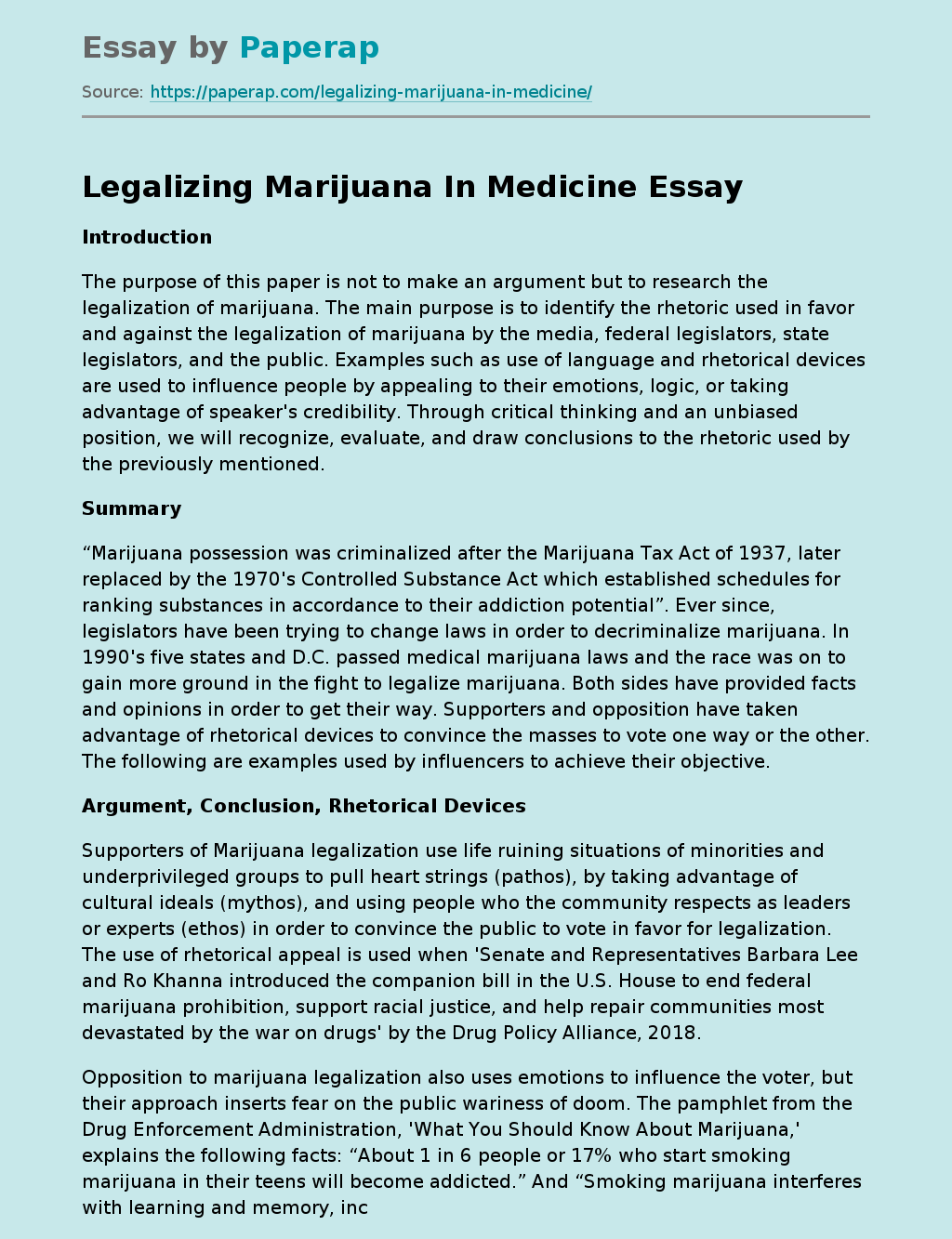Legalizing Marijuana In Medicine
Introduction
The purpose of this paper is not to make an argument but to research the legalization of marijuana. The main purpose is to identify the rhetoric used in favor and against the legalization of marijuana by the media, federal legislators, state legislators, and the public. Examples such as use of language and rhetorical devices are used to influence people by appealing to their emotions, logic, or taking advantage of speaker’s credibility. Through critical thinking and an unbiased position, we will recognize, evaluate, and draw conclusions to the rhetoric used by the previously mentioned.
Summary
“Marijuana possession was criminalized after the Marijuana Tax Act of 1937, later replaced by the 1970’s Controlled Substance Act which established schedules for ranking substances in accordance to their addiction potential”. Ever since, legislators have been trying to change laws in order to decriminalize marijuana. In 1990’s five states and D.C. passed medical marijuana laws and the race was on to gain more ground in the fight to legalize marijuana.
Both sides have provided facts and opinions in order to get their way. Supporters and opposition have taken advantage of rhetorical devices to convince the masses to vote one way or the other. The following are examples used by influencers to achieve their objective.
Argument, Conclusion, Rhetorical Devices
Supporters of Marijuana legalization use life ruining situations of minorities and underprivileged groups to pull heart strings (pathos), by taking advantage of cultural ideals (mythos), and using people who the community respects as leaders or experts (ethos) in order to convince the public to vote in favor for legalization.
The use of rhetorical appeal is used when ‘Senate and Representatives Barbara Lee and Ro Khanna introduced the companion bill in the U.S. House to end federal marijuana prohibition, support racial justice, and help repair communities most devastated by the war on drugs’ by the Drug Policy Alliance, 2018.
Opposition to marijuana legalization also uses emotions to influence the voter, but their approach inserts fear on the public wariness of doom. The pamphlet from the Drug Enforcement Administration, ‘What You Should Know About Marijuana,’ explains the following facts: “About 1 in 6 people or 17% who start smoking marijuana in their teens will become addicted.” And “Smoking marijuana interferes with learning and memory, increasing the risk of poor grades and dropping out of school.” Research shows it can lower your IQ if you smoke it regularly in your teen years.
The site, Foundation for a Drug-Dree World, entices the reader to find the truth about drugs. Although this website also provides the reader with facts it portrays a negative, dark, and life ruining side of marijuana by using (Innuendos) a way of saying something without overtly saying it. In this case, it does this with dark colors and images of persons gathered around skulls and other paraphernalia laying down on a couch and smoking. The site uses (dysphemism) by using a negative word such as “poisonous” and “kill” to make the expression sound worse. ‘You may have heard someone say that because marijuana is a plant, it’s ‘natural’ and so it’s harmless. But it’s not. Hemlock, a poisonous plant, is also ‘natural,’ but it can kill’ by the website Foundation for a Drug-Free World.
Both sides of the issue may provide convincing evidence, but the evidence is one-sided. If the public is to make informed decisions it must use critical thinking when analyzing information presented. Upon research, the peer reviewed article titled, ‘Support for Marijuana Legalization and Predictors of Intentions to Use Marijuana More Often in Response to Legalization Among U.S. Young Adults’ may seem biased by the title, but upon critical review, the article uses keywords such as studies, data proven, surveys, and clinical results when presenting information, this is to be taken as fact, and in order to prove their facts, they make use of charts with objective data. Since the title can be misleading, it takes some deductive logic to see the article as unbiased, the article never recommended legalization nor claimed pro or against use.
Gatekeepers
Gatekeepers are persons who control access to something. In this case it would be the ones who are controlling the marijuana and how it presented to the audience. Audience interprets the use of marijuana in many ways. People can either interpret it in a good or bad way. For example, many people see marijuana as the medical use of it. It has been said that medical marijuana is a great pain med. Anne Harding, the author of Medical Marijuana on WebMD states that medical marijuana. “helps with muscle spasms which is cause by multiple sclerosis, nausea from cancer and chemotherapy, poor appetite and weight loss by chronic illnesses, nerve pain, seizure disorders, etc.”
Yes, doctors indeed have said that marijuana helps those who really need it. The audience that is intended to use it as a medical medicine see the legalization of marijuana as a positive thing. Then, there are those people who use marijuana to get a “good high” they use it because it makes them feel good. These people also see marijuana as a good thing. However, parents especially those old-schooled ones may see this as a bad thing for their “kids”. Marijuana is still technically considered a drug. With this said many people have a negative view about marijuana and how it is a drug and it can cause death. Both sides, the positive and the negative are seen. Every individual takes it the way they want.
Biases
Biases are prejudices in favor or against one particular thing. Many individuals are for and against the legalization of marijuana. Some are in favor because they either use it themselves or have someone that uses it and are supporters. Yet, there are other individuals who are against the legalization of marijuana. These individuals typically see it as a drug that can kill. Just like any other drug, misuse of this substance can lead to complications and death. It is a matter of being able to control the dosages of consumption. Culture plays a big role in how people see marijuana as in favor or against. Some older folks tend to assimilate that marijuana is a drug therefore it should stay illegal due to its background. Like mentioned above personal beliefs also play a big role to what people assume of the topic. Marijuana and the topic of legalization can have many influences. Beliefs, religion, influences, friends, all contribute to what side people take.
Fallacies
The Straw Man fallacy occurs when a speaker or writer attempts to dismiss a contention by distorting or misrepresenting it. An example would be “You: I think we should legalize marijuana, Friend: Maybe you think everyone should go around stoned, but I think that’s absurd.” Here, the friend is misrepresenting the topic by concluding that if marijuana is legalized everyone would be high; nobody would want that. Moving on, the Bandwagon fallacy refers to the fact that sometimes by mentioning the popularity of a proposition, a speaker or writer may not be trying to offer evidence of its truth, instead, he or she may be dangling a psychological inducement to believe it. He or she may be playing on the natural human tendency to want to be a part of things, to be part of the group. For instance, ‘a criminal conviction can be a barrier to employment, housing and other benefits, so instead of waiting for the community to take action, we are taking action for the community,’ he added.
To explain this, San Francisco District Attorney George Gascón said Wednesday that his office will dismiss and seal 3,038 misdemeanor convictions dating back before the state’s legalization of marijuana went into effect, with no action necessary from those who were convicted. Petitioning to have a record expunged has been in place, but can be costly and it can require legal help, Gascón said in a statement. He said only twenty-three petitions were filed this past year in the city. Lastly, Argument by Anecdote is a story. When a speaker or writer tries to support a general claim by offering a story, he or she commits the fallacy. For example, the debate over the therapeutic benefits of medical marijuana is ongoing. While a number of states in the U.S. have active medical marijuana laws, the federal government continues to classify it as a Schedule I controlled substance. Not only does that make it illegal to possess, it also limits medical studies into the potential benefits of cannabis. This can be interpreted as a story of how marijuana is still illegal.
Analysis
According to the journal, Medical marijuana users in substance abuse treatment, “demonstrating the impact of marijuana use on treatment outcomes is important for developing an expansive evidence-base for treatment alternatives. Examining the negative, positive, or neutral consequences of marijuana use is also critical for evaluating abstinence-only and harm reduction models for addiction treatment”. First of all, identifying the problem more extended research of marijuana use should be done in order to find the best form of treatment for marijuana users. Secondly, gathering the data from the California Outcomes Measurement System (CalOMS) were compared for medical (authorized) marijuana users and non-marijuana users who were admitted to a public substance abuse treatment program in California.
Behavioral and social treatment outcomes recorded by clinical staff at discharge and reported to the California Department of Alcohol and Drug Programs were assessed for both groups, which included a sample of eighteen reported medical marijuana users. This exploratory study suggests that medical marijuana is consistent with participation in other forms of drug treatment and may not adversely affect positive treatment outcomes. Following that, these findings call for more extensive sampling in future research to allow for more rigorous research on the growing population of medical marijuana users and non-marijuana users who are engaged in substance abuse treatment. Researchers do not give a precise answer to the solutions as they request for further research being necessary to provide the accurate results. Once different ways are found in order to approach treatment, marijuana users may have a higher chance of reducing or stop the usage of marijuana.
By finding different methods a person will be able to follow the treatment that would best suit her/him in order to have the desired results. Lastly, moving forward with a solution it is best to provide different types of methods to complete a treatment because the same process might not work with everyone that is seeking treatment. People tend to work better with something that he or she can be more comfortable with. If the practice becomes too difficult or uncomfortable for the patient, then the chances of having a successful and completed recovery will not be high. Patients would have the opportunity to test out what works for them best and therefore abide by the rules or prerequisites necessary to complete the specific treatment they choose.
Legalizing Marijuana In Medicine. (2021, Dec 14). Retrieved from https://paperap.com/legalizing-marijuana-in-medicine/

